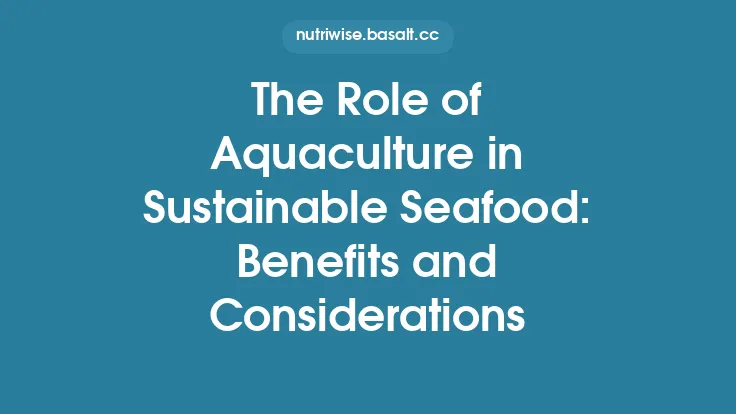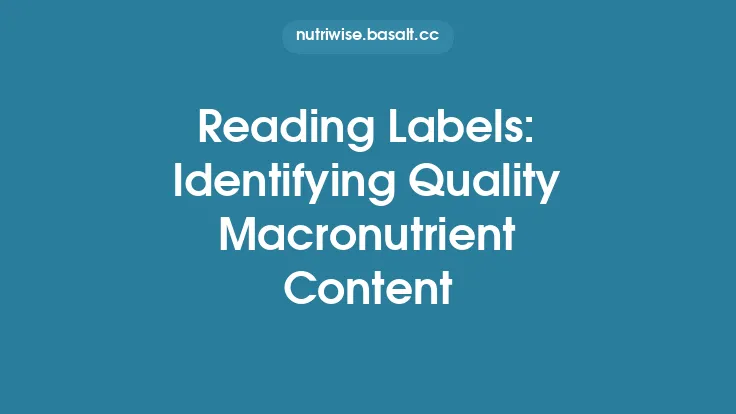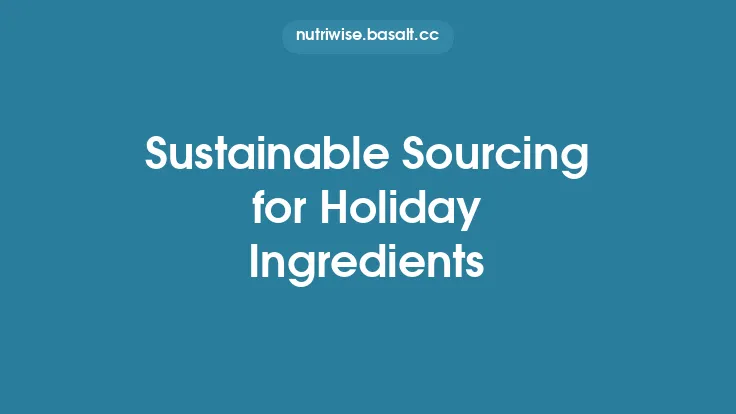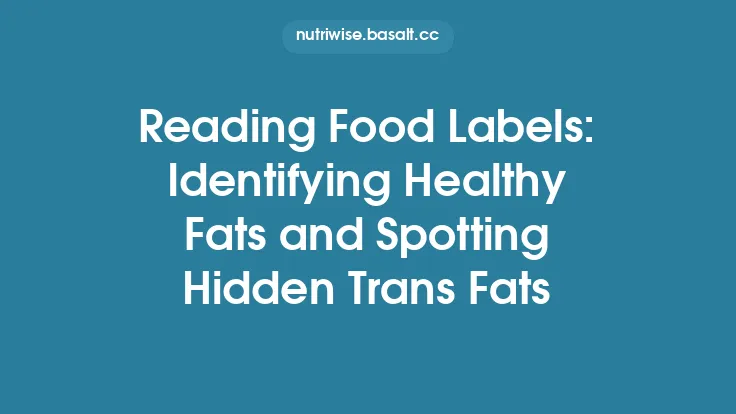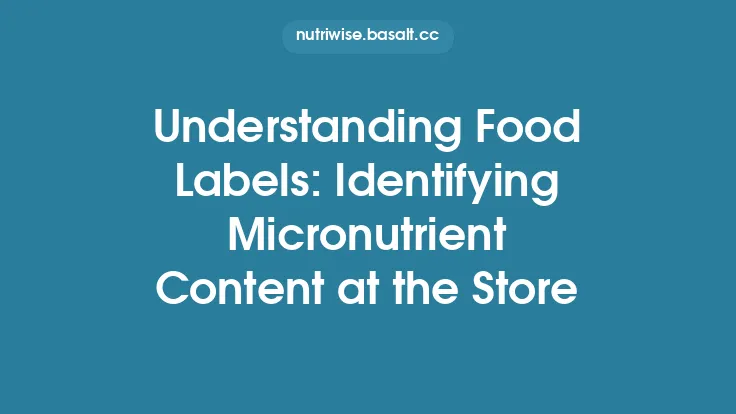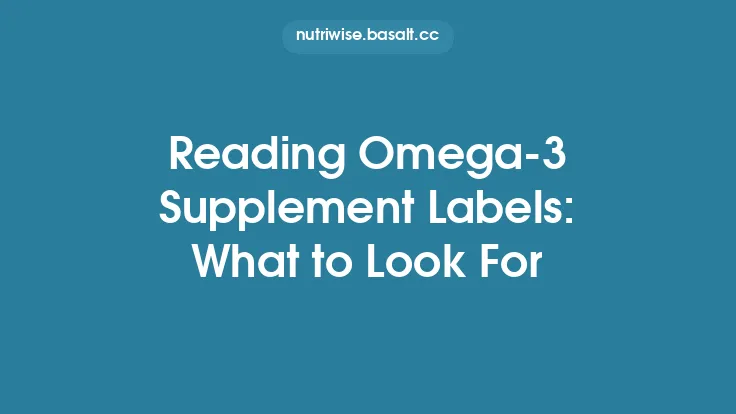Seafood is one of the most nutrient‑dense foods you can put on the table, but the sheer variety of labels, claims, and certifications can feel overwhelming. A well‑read label not only tells you what you’re eating, it also reveals how that product was harvested, processed, and transported—information that is essential for making truly sustainable choices. By learning to decode the language on seafood packaging, you can align your purchases with environmental stewardship while still enjoying the flavors and health benefits you love.
Understanding the Core Elements of a Seafood Label
A typical seafood package contains several distinct sections, each serving a specific purpose:
| Element | What to Look For | Why It Matters |
|---|---|---|
| Product Name | Scientific (Latin) name vs. common name | Scientific names reduce ambiguity; common names can be vague or region‑specific. |
| Net Weight | Exact weight (e.g., 200 g) | Helps you compare price per kilogram and avoid over‑purchasing. |
| Country of Origin | Country or region where the fish was caught or farmed | Indicates the regulatory environment and potential environmental impact. |
| Harvest Method | “Wild‑caught,” “line‑caught,” “trawl‑caught,” “pond‑raised,” “recirculating system” | Different methods have varying levels of habitat disturbance, bycatch, and carbon footprint. |
| Date Information | “Best before,” “use by,” or “freeze date” | Guides freshness and storage decisions. |
| Nutrition Facts | Calories, protein, omega‑3s, sodium, etc. | Allows you to balance health goals with sustainability. |
| Certification Logos | Third‑party symbols (e.g., ASC, BAP, Dolphin‑Safe) | Provide an external audit of sustainability claims. |
| Additional Claims | “Ocean‑friendly,” “responsibly sourced,” “traceable” | May be marketing terms; verify their backing. |
Understanding each of these components equips you to ask the right questions and spot red flags before you reach for the checkout.
Common Sustainability Claims and Their Real Meaning
| Claim | Typical Interpretation | Verification Tips |
|---|---|---|
| “Sustainably sourced” | Generic promise of responsible harvesting | Look for a specific third‑party logo; otherwise, request documentation from the retailer. |
| “Wild‑caught” | Fish taken from natural habitats | Check the harvest method (line, trap, etc.) to gauge ecosystem impact. |
| “Farm‑raised” | Fish produced in aquaculture | Identify the farming system (e.g., recirculating aquaculture system vs. open‑net pens). |
| “Traceable” | Ability to follow the product’s journey from sea to shelf | Some brands provide QR codes linking to detailed supply‑chain data. |
| “Low impact” | Minimal environmental footprint | Verify through certifications or independent assessments; vague claims may lack substance. |
| “Dolphin‑Safe” | No dolphin mortality in the fishery | Usually tied to specific fisheries; confirm the geographic scope. |
When a claim is paired with a recognized certification logo, its credibility increases dramatically. In the absence of such symbols, treat the claim as a starting point for further inquiry rather than a guarantee.
Decoding Country of Origin and Harvest Method
Why Country Matters
Regulatory standards for fisheries and aquaculture differ widely. Countries with robust monitoring (e.g., Norway, Canada, New Zealand) often enforce stricter limits on catch quotas, habitat protection, and waste management. Conversely, regions with limited oversight may have higher rates of illegal, unreported, and unregulated (IUU) fishing.
Harvest Method Details
| Method | Environmental Profile | Typical Species |
|---|---|---|
| Line‑caught (e.g., longline, handline) | Low habitat disturbance; moderate bycatch depending on gear | Cod, halibut, tuna |
| Trap‑caught (e.g., pots, crab traps) | Minimal seabed impact; low bycatch | Lobster, crab, certain reef fish |
| Trawl‑caught (bottom or midwater) | High seabed disruption; significant bycatch | Shrimp, some flatfish |
| Pond‑raised (freshwater) | Controlled environment; potential for nutrient runoff | Tilapia, catfish |
| Recirculating Aquaculture System (RAS) | Closed‑loop water use; low effluent; higher energy demand | Salmon, trout |
| Open‑net pens | Direct interaction with wild ecosystems; risk of escapes and disease | Salmon, sea bass |
When the label specifies the harvest method, you can quickly assess the likely ecological footprint. For example, a “line‑caught” cod from Norway generally carries a lower impact than a “trawl‑caught” cod from a region with lax regulations.
Wild‑Caught vs. Farm‑Raised: Terminology to Watch
The binary “wild vs. farm” is often oversimplified. Look for qualifiers that reveal the nuance:
- “Wild‑caught, line‑caught” – Indicates selective gear, reducing habitat damage.
- “Wild‑caught, trawl‑caught” – Signals higher ecosystem disturbance.
- “Farm‑raised, recirculating system” – Suggests a closed environment with controlled waste, though energy use may be higher.
- “Farm‑raised, open‑net pen” – Implies interaction with surrounding waters, potential for escapes, and disease transmission.
Some labels also mention “semi‑wild” or “enhanced” for species that are wild‑caught but later held in holding tanks before processing. This can affect freshness and the carbon footprint associated with storage.
Recognizing Third‑Party Verification Symbols
Third‑party certifications are the most reliable way to confirm sustainability claims. While the MSC (Marine Stewardship Council) certification is widely known, it falls under the neighboring article’s scope, so we’ll focus on other reputable programs:
- Aquaculture Stewardship Council (ASC) – Audits farmed seafood for environmental and social criteria, emphasizing responsible feed use, water quality, and community impact.
- Best Aquaculture Practices (BAP) – A comprehensive program covering environmental, social, and food safety standards for farmed species.
- Friend of the Sea (FOS) – Provides certification for both wild‑caught and farmed products, with a focus on ecosystem impact and traceability.
- GlobalG.A.P. (Aquaculture) – Primarily a food safety standard, but includes modules on environmental management.
- Dolphin‑Safe – Specific to tuna fisheries, ensuring no dolphin mortality during the catch.
When you see one of these logos, verify that the certification is current (most display the year of audit) and that the logo is not a generic “green” symbol. Many brands now embed QR codes that link directly to the certification body’s database, allowing you to confirm the product’s status instantly.
Navigating Nutritional Information and Sustainability
Sustainability and nutrition often intersect, but they are not always aligned. A label may highlight high omega‑3 content while the harvest method carries a high environmental cost. To balance both aspects:
- Check the omega‑3 to total fat ratio – Species with a high proportion of beneficial polyunsaturated fats (e.g., certain wild‑caught fish) are nutritionally superior.
- Assess sodium and additives – Some processed seafood (e.g., breaded fish sticks) contain high sodium or preservatives, which can diminish health benefits.
- Look for “no added preservatives” – Indicates minimal processing, often associated with fresher, less resource‑intensive handling.
By cross‑referencing the nutrition panel with the sustainability data, you can prioritize products that deliver both health and environmental value.
Red Flags: Misleading or Unregulated Terms
| Term | Why It’s Problematic | What to Do |
|---|---|---|
| “All‑natural” | No regulatory definition for seafood; may simply mean no artificial colorants. | Verify ingredient list; focus on harvest method instead. |
| “Eco‑friendly” | Purely marketing language unless backed by a certification. | Seek third‑party verification. |
| “Wild‑caught” without method | Hides the gear type, which could be destructive. | Look for additional details or ask the retailer. |
| “Sustainably sourced” without logo | Unsubstantiated claim. | Request proof of certification or choose a product with a recognized symbol. |
| “Fresh” on frozen products | “Fresh” can be used loosely; frozen fish may be flash‑frozen at sea, which is actually a good practice for preserving quality. | Check the freeze date and origin; consider the supply chain’s carbon impact. |
| Vague origin (“Pacific Ocean”) | Too broad to assess regulatory context. | Prefer specific country or region. |
When any of these red flags appear, it’s wise to pause and either seek more information or select an alternative product with clearer labeling.
Practical Tips for Shopping and Verifying Labels
- Start with the scientific name – If the label lists *Gadus morhua* instead of “cod,” you know exactly which species you’re buying.
- Prioritize specific origin – A product from “British Columbia, Canada” is more traceable than one labeled simply “North Atlantic.”
- Scan for certification logos – Keep a mental checklist of the symbols you trust; if none appear, consider asking store staff for details.
- Use mobile apps – Several free apps let you scan barcodes and instantly retrieve sustainability data from reputable databases.
- Buy from reputable retailers – Stores with transparent sourcing policies often provide additional documentation on request.
- Consider bulk or whole‑fish purchases – Whole fish typically have fewer processing steps, reducing waste and energy use.
- Check the packaging date – Freshness matters for both taste and nutrient retention; a recent freeze date is a good sign.
- Look for “traceability” features – QR codes or batch numbers that link to a supply‑chain map add confidence.
By integrating these habits into your routine, you’ll develop a reliable system for selecting seafood that aligns with both your health goals and environmental values.
Resources for Ongoing Education
- Government fisheries agencies – Many publish up‑to‑date stock assessments and guidelines for consumers.
- Non‑profit seafood guides – Independent organizations often maintain searchable databases of certified products.
- Scientific journals – Articles on fishery management and aquaculture practices provide deeper insight into emerging sustainability metrics.
- Industry webinars – Some certification bodies host free sessions explaining label terminology and audit processes.
- Community forums – Engaging with other conscious consumers can surface brand recommendations and local sourcing tips.
Staying informed is a continuous process. As labeling standards evolve and new certifications emerge, regularly revisiting these resources will keep your seafood choices both delicious and responsible.
